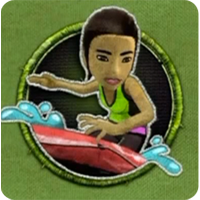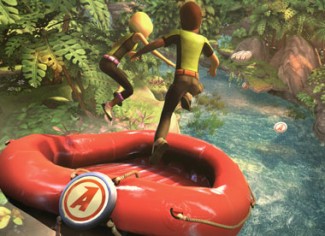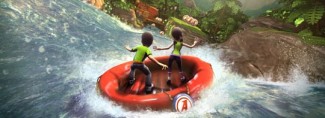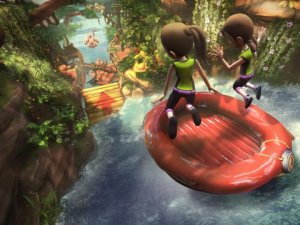Bastion
LQ: 9.15
Recommended Age: 10+
Skills Used: Planning, Working Memory, Mathematics, Reading

In this game, up to two players stand in front of the Kinect sensor and their likeness is represented on the screen, standing in a raft. At the start of each course, characters are sent rushing down a river, and players must control the raft using their body. To steer the raft players move from side to side, and can make the raft leap into the air by jumping in front of the Kinect sensor. Players must work as a team to earn as many points as possible, avoiding obstacles like barrels and wood to keep the raft in motion. Players can earn points by collecting pins scattered throughout the course, however, they are not always easy to attain. Players will have to launch the raft off ramps, seek out hidden paths and even glide over clouds in an effort to collect them all. Because the game features no violence, has simple controls and requires no reading or other academic skills, it is recommended for players ages 6 and up.
Note: This game has been identified as helpful for kids with ADHD. Click here to find out why.
Recalling and retaining information in her mind while working.

This game helps players practice their Working Memory skills by encouraging them to recall the layouts of the game’s many courses in order to earn as many points as possible. Crashing the raft slows players down and hurts their score, making it important to learn the tricky areas of each level, memorizing ramps and hazards to avoid costly collisions. Also, by remembering where pins are located, players have a better chance of maximizing their score by recalling when and where to steer their raft in order to collect these hard-to-reach points.
Adapting and adjusting to changing conditions and expectations.
This game also helps players practice their Flexibility skills by encouraging them to think on their feet. Players are given the task of frequently 'jumping' throughout different parts of the level. In order to avoid crashing and collect the pins, players will need to hop at the right moment. If they don't think fast and move quickly, they'll end up not jumping at the right moment, crashing more frequently and missing opportunities to grab pins as they pass by.
Use this PlayTogether guide to learn how you can help your child turn Kinect Adventures: River Rush play time into a positive learning and relationship-building experience. To learn more about why playing games with your children is so important, check out our Science of Play page!
Take a minute to talk with your child about how the Working Memory and Flexibility thinking skills work, and why they are important for success in school and at home.
 Kinect Adventures: River Rush can be experienced as both a single, and multiplayer game, so the best way to play with your child is to play cooperatively. Because Kinect Adventures: River Rush lets players enjoy the action simultaneously, both players can work together to meet our gameplay goals. Take a moment to examine the goals listed below, and then try to complete them with your child.
Kinect Adventures: River Rush can be experienced as both a single, and multiplayer game, so the best way to play with your child is to play cooperatively. Because Kinect Adventures: River Rush lets players enjoy the action simultaneously, both players can work together to meet our gameplay goals. Take a moment to examine the goals listed below, and then try to complete them with your child.
Gameplay Goals:
 After you have played through ten rounds of of Kinect Adventures: River Rush, take a minute to pause the game and talk with your child about how the game is exercising your Thinking Skills.
After you have played through ten rounds of of Kinect Adventures: River Rush, take a minute to pause the game and talk with your child about how the game is exercising your Thinking Skills.
Our Make it Real activites are designed to transform your child’s gameplay into real-world improvements in thinking and academic skills. If you’re just getting started with LearningWorks for Kids, we suggest you try them all to find which are the best for you and your child.
Read over the pages for Working Memory and Flexibility. Then take some time to introduce these thinking skills to your child.
Explain That:

Use visual reminders for regularly practiced tasks. For example, a series of “leaving for school” pictures might be posted near the door. These might include pictures of a child brushing her teeth, putting lunch into a book bag, and kissing mom or dad goodbye. Encourage your child to develop her own set of visual aids for memory. Practicing visualization skills, such as keeping an image in mind of what she wants to remember, could also help improve your child’s memory.
Offer win-win chances to try new things in order to help your child expand the scope of things he finds acceptable. For example, a blindfolded taste test for two kinds of chicken nuggets might show a fussy eater that he likes different flavors or textures in each of the samples. Try some experiments with his favorite activities or clothing to help your child see that his capacity to choose one or the other will expand his range of choices. Talk about how individuals are often happier when they are able to find many things that they like to do, eat, or enjoy.
Active, motion-based games can employ a great deal of movement and vigorous exercise, which studies have shown can change brain chemistry in a positive way that improves attention. Players must stay on their tows as they jump to dodge obstacles, jump to propel their raft and move left and right to steer. The game is also great for practicing Working Memory, a common problem areas for children with ADHD.
All membership plans come with full access to our entire suite of tools learning guides, and resources. Here are a few of the ones we think you’ll like the most: